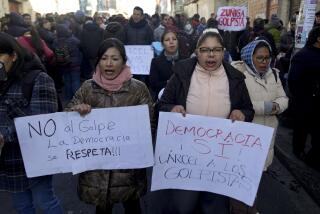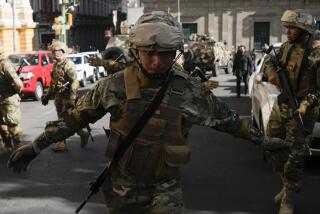Philippine Rebels Refuse to Give Up, Open New Attack : Coup attempt: Mutineers mount assault on army headquarters. Aquino’s ultimatum: ‘Surrender or die.’
- Share via
MANILA — Mutinous soldiers attempting to overthrow Philippine President Corazon Aquino refused to surrender early today, launching a fresh attack on army headquarters in this capital city despite heavy air force bombardments.
Aquino responded by issuing an ultimatum to the rebels, demanding that they “surrender or die,” and making clear that there would be no negotiation.
In a toughly worded statement, Aquino said that government forces would continue fighting “until the last trace of resistance is removed. We shall not entertain any offer to negotiate.”
She also accused leaders of the political opposition of financing and backing the coup and vowed to “root out those who have given aid and comfort to these traitors.”
“This national tragedy must not and will not be repeated. We shall hunt down and bring to justice the treacherous cowards who launched this attack,” she said.
However, Defense Secretary Fidel V. Ramos said in a radio broadcast today that the military had made contact with the rebels to try to persuade them to end the revolt. He did not elaborate.
At the same time, the military announced the arrest of one of the coup leaders, Lt. Col. Tito Legazpi, as he was en route to Bataan this morning to recruit followers for additional attacks against the government.
A government military spokesman, Brig. Gen. Oscar Florendo, said Legazpi took part in Friday’s assault on the Sangley Point naval air station, one of the garrisons seized by the mutineers in the sixth and most serious attempt yet to topple Aquino since she came to power in 1986.
Although the government maintained that the coup attempt was nearing an end, this morning’s rebel assault on Camp Aguinaldo, headquarters of the Philippine armed forces general staff, dashed hopes that the two-day-old insurgency would be quickly crushed, despite U.S. intervention.
Philippine fighter aircraft strafed rebel positions with 50-millimeter machine-gun fire just outside the army base--located in a densely populated part of Manila--and one helicopter pilot was reported wounded by rebel fire.
Manila Radio quoted military officials as saying that at least one government F-5 jet, streaking low over the battleground as part of the air attack, mistakenly hit government forces, killing six loyalist soldiers and wounding 20 others. An ammunition truck and nine jeeps were also destroyed.
“We thought the planes were friendly, but they fired at us,” said Brig. Gen. Thelmo Cunanan, commander of the government forces. “We were told later it was a case of mistaken identity.”
Defense Secretary Ramos said the incident “is one of those things that happen in a situation like this.”
Manila radio stations initially identified the planes as being American, but both Filipino and U.S. officials said no U.S. warplanes were involved in today’s fighting. A statement issued by the U.S. Embassy in Manila said that American F-4 Phantoms ceased flights over the capital at 6 a.m., one hour before today’s fighting began.
“We’re not doing any bombing, just doing cover missions,” said spokesman Lt. Kim Urie at Clark Air Base.
On Friday, U.S. jets flew air cover for government forces in an effort to help end the insurgency.
President Bush authorized deployment of the planes after a request by Aquino. An embassy spokesman said the cover could be resumed if necessary.
With U.S. planes at their side, Philippine jets blasted a rebel-held naval base south of Manila from which anti-Aquino pilots raided the palace and bombed two loyalist camps during a day of intermittent heavy fighting.
At least 24 people were killed, as many as 11 of them civilians, and 87 other people were wounded in Friday’s battles.
By midnight Friday, Aquino’s forces had recovered all three rebel-held military bases around the capital and two television stations, reporters at the scene said.
Aquino said in a radio address Friday night: “The enemy . . . is routed, but he is not yet vanquished. There is still a lot of fighting to be done to wipe off the last trace of resistance to the duly constituted government.”
Aquino, who took office in February, 1986, after a popular uprising drove the late President Ferdinand E. Marcos into exile in Hawaii, and her military leaders expressed confidence today that the end of the revolt was near.
Brig. Gen. Rodolfo Biazon, chief of the National Capital Region Defense Command, estimated that no more than 300 rebels remained in the capital.
“Hopefully within the day we will finish them off,” Biazon said.
Estimates of rebel strength at the high point of the insurrection ranged from 800 to 2,000.
One city official described today’s fighting as mopping up and predicted the capital would soon return to normal.
The rebels, after being forced out of their strongholds, began heading for Aguinaldo, apparently for a last stand on Manila’s streets. The rebel ranks swelled when marines from Ft. Bonifacio, the rebels’ home garrison, joined them. The column was backed by several armored vehicles.
A senior U.S. defense official said in Washington that, as dawn approached, “by no means is the fighting over.”
He said Aquino was in the presidential palace and “very well protected.”
U.S. Air Force F-4 Phantom jets from Clark Air Base, 50 miles north of Manila, roared over the city Friday, halting rebel air attacks. The rebels had raided the presidential palace, military camps and a television station earlier in the day with planes and helicopters.
The American action enabled Aquino’s government to consolidate its forces and block rebels from moving against the palace and other points in the capital.
Gen. Renato de Villa, military chief of staff, said the sixth coup attempt against the Aquino government had failed.
None of the mutinous soldiers questioned would say who directed the revolt. Rebel sources said the leaders included renegade Lt. Col. Gregorio (Gringo) Honasan, who led an August, 1987, coup attempt in which at least 53 people were killed.
Honasan has been at large since his escape from prison in April, 1988.
He supported Aquino when she came to power, but turned against her because of the government’s alleged failure to end corruption and curb a Communist insurgency.
Legazpi, the alleged rebel leader arrested today, had been sought since that August coup attempt.
Before the U.S. intervention, two rebel T-28 aircraft bombed and rocketed Malacanang Palace compound. Witnesses reported five people killed, including two presidential guards.
Other air raids damaged the headquarters building of the Philippine Constabulary national police at Camp Crame and the home of De Villa at Camp Aguinaldo.
A Bush Administration official said U.S. planes began flying over the two rebel-held Philippine air bases, Sangley Point and Villamor, after authorization was received at 1:32 p.m. Manila time (9:32 p.m. PST).
About 100 U.S. Marines were sent from an American base to help protect the U.S. Embassy, but the Administration official said American ground troops were not involved in any action.
Pentagon spokesman Pete Williams said no U.S. planes “fired any shots or intercepted any rebel aircraft.”
“President Aquino’s request was very specific . . . to conduct an aggressive cap over two Philippine air bases, Villamor and Sangley Point,” the Administration official said, on condition of anonymity.
A spokesman for the rebels said the U.S. move was an affront to Filipino sovereignty and the mutineers would hold Ambassador Nicholas Platt personally responsible for the intervention.
About 40,000 U.S. military personnel, dependents and Defense Department civilians are stationed at six bases in the Philippines. Orders were issued restricting their travel and Americans were told to stay in their homes.
In addition to those assigned to the bases, more than 100,000 Americans live in the Philippines, according to the Embassy.
Most of the mutineers appeared to be from the army and marines, considered the best of the archipelago’s 160,000-member armed forces.
Filipino journalists said rebels also seized the airport near Legazpi, 220 miles southeast of Manila.
Retired Brig. Gen. Jesus Hermosa, a security adviser in Cebu province, said a boatload of rebels landed near Cebu City’s airport, the second largest in the Philippines, 350 miles southeast of Manila.
A bomb dropped by one of the rebel planes knocked out the government television station RPN and rebel forces captured a private station. Witnesses said two pro-government soldiers and three civilians were killed in fighting near RPN.
Officials reported a pro-government major killed when his F-5 jet crashed in Cavite province and two rebels killed at Sangley Point.
Thousands of civilians fled neighborhoods around the suburban military garrisons, but others stayed to watch the fighting.
De Villa estimated rebel strength at 800, but a captain among the mutineers put the number at 2,000. The chief of staff also said that troops in northern Luzon, Mindanao and in the southern Luzon command remained loyal.
Gov. Rudolfo Aguinaldo of Cagayan province said in a radio interview Friday morning, however, that soldiers in his northern Luzon area supported the mutiny and “we are bringing in artillery and armor.”
During the coup attempt in August, 1987, civilians poured into the streets to support Aquino and cheer government forces, but this time, people watched in silence. Public discontent with the Aquino government has grown because of rising prices, an electricity shortage and allegations of corruption among her relatives and supporters.
PAST COUP ATTEMPTS Some previous efforts to overthrow Corazon Aquino: July 6, 1986 Pro-Marcos military officers take over the Manila Hotel and declare Marcos’ vice presidential running mate, Arturo Tolentino, president. They surrender two days later. Nov. 23, 1986 Government says Fidel V. Ramos, chief of staff, blocked a coup plot by military officers. Jan. 27, 1987 Marcos loyalists and mutinous troops try to seize military and media installations in the capital. The mutineers hold a TV station for 61 hours before surrendering. Aug. 27, 1987 Rebels led by Lt. Col. Gregorio Honasan attack presidential palace, radio and TV stations and military headquarters. At least 53 people are killed and more than 300 wounded. Loyal troops end the coup attempt about 14 hours later after marines storm armed forces headquarters which had fallen into rebel hands.
More to Read
Sign up for Essential California
The most important California stories and recommendations in your inbox every morning.
You may occasionally receive promotional content from the Los Angeles Times.










